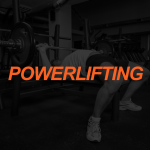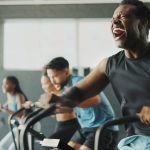
To perform well in kickboxing, karate, and most martial art forms, one must develop strength, power, and muscular endurance. If you have sparring clients, understanding the foundations of kickboxing and martial arts fitness is paramount to training these athletes. Read on to learn how to design appropriate programs to improve kickboxing and karate performance.
Important Fitness Components
Strength is the ability to exert force against resistance. In kickboxing it is the force of a punch and/or a kick against one’s opponent. The same is true in self-defense. Strength is developed by performing resistance exercises with heavyweight and lower repetitions (1-6) in each set. Lifting heavy, i.e., 90% of one-repetition maximum weight (1RM), done correctly will increase strength by recruiting high-threshold motor units.
Muscular endurance is the ability of muscles to manage some weighted resistance for an extended period of time. Endurance resistance exercise will use light weights with higher repetitions in each set.
Power is explosive force. It is the ability to exert maximum muscular contraction quickly in an explosive burst of movement, with minimum rest time between sets. Exercises that develop power include jumping with weights or throwing weights. The Olympic lifts “clean and jerk” and “power clean” are also considered power training on account of the explosive speed required to perform the lift.
There are workouts that can develop lower body speed that include, but aren’t limited to: sled pushes, ladder drills, and/or interval runs. High-Intensity Interval Training (HIIT) will strengthen the heart and lungs, building stamina. HIIT can include intense interval aerobic exercise, e.g. sprints.
Strength, endurance, and power training for kickboxing should be implemented gradually, i.e. slowly increasing resistance. When one can do more than the required repetitions (usually 7 to 8 reps) in a particular set using 65-70% of the 1RM weight performed correctly, it’s time to increase the weight.
Understanding Muscle Fibers
The foundations of kickboxing and karate fitness are rooted in knowing which muscle fibers are recruited for thesse activities. We know that there are three muscle unit types: type 1, type IIA, and type IIB. Type I, or slow-twitch fibers, have a lower threshold for activation, low conduction velocity, and are powered by oxygen—these are our endurance fibers utilized during aerobic activity. Type 1 fibers are darker in color on account of being more densely populated with mitochondria.
Type II have a higher activation threshold conducting signals at higher velocities. Type IIB are anaerobic muscle fibers, which have a colorless appearance due to the lack of mitochondria. These fibers fatigue quickly on account of low stored energy, gained from glycogen and ATP stores. Type IIB fibers are utilized for strength and power activities; they have few capillaries, low endurance, but are high in power generation. When these fibers are taxed, lactic acid is the byproduct, and recovery time is required between sets, usually around 2 to 4 minutes.
Finally type IIA fibers are a hybrid of type I and type II, with a rich blood supply and many mitochondria, utilized too rapidly for high force production. Think stair climbing or walking uphill.
Strength or Size?
Rather than focusing on sarcoplasmic hypertrophy where the size of the muscle is valued, and developed by swelling the muscle belly with fluids, developing myofibrillar hypertrophy is the goal when working with a kickboxer or martial artist. This is the process by which strength is developed. The thickness of individual actin and myosin protein filaments improves the force production of the individual fibers, resulting in thicker muscle fibers.
Sarcoplasmic hypertrophy, favored by bodybuilders, increases the volume of the semifluid inter-fibrillar substance which contains the proteins used for tissue repair.
The kick-boxer/karate professional will need training that generates higher amounts of force, the kind that develops sarcoplasmic strength. This force is used for dynamic movements, incorporating type II fibers which have greater cross-width than type 1 fibers. [Please reference: The Anatomy of Martial Arts, An Illustrated Guide to Muscles Used in key Kicks, Strikes & Throws by Dr. Norman Link and Lily Chou]
Exercises for Kickboxing and/or Karate:
Strength training should include 2 to 6 sets of 5 to 8 repetitions performed with weight that is 80% of 1RM. Power training is done back-to-back, 3 to 5 sets with 7 repetitions for each muscle group at 80% of 1RM performed correctly. Endurance involves as many repetitions you can perform in three sets at 40-65% of 1RM done correctly, increasing the fatigue factor in each set.
Rotator cuff, trapezius, shoulder
Overhead Press
Middle back/Latissimus Dorse
Bentover Barbell Row
Quadriceps/Gluteals
Barbell Back Squat
Pectorals, triceps
Barbell Bench Press
Lats, biceps
Barbell Pullover
Calves
Standing Calf Raise
In my following article, I will explore the importance of incorporating negative lifting into the resistance training program as well as addressing the cardiorespiratory fitness required to excel at all combat sports.
Summary
All combat sports require a trainer/coach for the athlete’s proper development gained by grasping the basics and foundations of kickboxing and karate fitness. The coach should design the athlete’s workout schedule so that proper development occurs without injury.
Kick-boxing/karate requires physical conditioning to develop one’s endurance, speed, power, and strength. Physical conditioning starts by preparing specific muscle groups for the demands and stretching them to cool down and recover at the end. Physical conditioning for the karate or kickboxing professional will develop myofibrillar hypertrophy, i.e. thicker muscle fibers for maximum strength and force production.
Resistance exercises should include negative eccentric repetitions that build stronger muscles and protect connective tissue against strain and injury, making them fortified and more resilient.
DISCLAIMER
Any person engaging in a combat sport must be trained by a qualified coach. My expertise as a professional trainer in kickboxing and karate provides information behind strength and endurance to participate in the same, and not directly provide oversight to your development in a combat sport. Your development/skill in karate is determined by your coach. When two karate opponents bow before training and/or competition, the bow signifies either can be hurt, suffer a concussion, sprain, strain, bone fracture, and the like; and the bow to you and your opponent will accept the fact that you can be hurt. As with any sport, there is a risk of injury, including paralysis and/or death which is inherent in all activities involving physical exertion, exercise, and the like. If you decide to use an air-resistant device, then it should be undertaken with proper supervision and without supervision should not be undertaken or permitted.
Dr. Brancato has 48 years of martial arts experience, attaining skills in kickboxing 1st Dan and Kenpo Karate, currently 4th Dan, to test for his 5th Dan in Aug 2022. Dr. Brancato was one of the main sparring partners for two-time middle-weight kickboxing champion Dan Magnus.
Recognition is given to Master Bruce Lee (Jeet Kune Do), Dan Inosanto (authority in Filipino Martial Arts); Bas Rutten (MMA Champion); Dan Magnus (two-time world kickboxing champion, best known for being the only person to defend his championship title after open-heart surgery)






